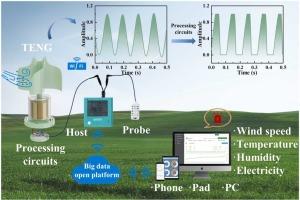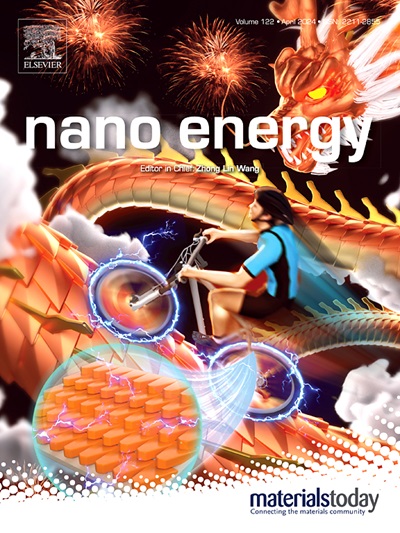基于非接触式三电纳米发电机的风速和风向远程监控系统
IF 16.8
1区 材料科学
Q1 CHEMISTRY, PHYSICAL
引用次数: 0
摘要
风速和风向传感器是物联网(IoT)中的重要传感器类别,在气象监测、建筑工程、交通工程和海洋工程等领域尤为重要。然而,电力供应仍然是限制这些传感器在大规模传感器网络中广泛应用的关键因素。本文提出了一种基于三电纳米发电机(SD-TENG)的自供电非接触式风速风向传感器。经过优化的风速测量结构的启动风速低至 0.2 m/s,并在 0.2-29 m/s 的范围内表现出良好的线性。此外,该传感器还具有较高的耐温性和耐湿性,在环境温度为 45°C 时电压衰减为 2.4%,在相对湿度为 95% 时电压衰减为 9.8%。在风向测量方面,非均匀电极的设计增强了不同通道的识别能力。为满足远程监控的需求,我们设计了一种先进的信号处理电路,可直接将风速传感器的原始输出转换为风速信息,并通过主机上传到云平台。该系统不仅能实时记录和显示风速数据,还具有历史数据存储和报警功能,提高了风速监测的智能化和自动化水平。此外,用户还可以通过电脑和移动设备访问和分析风速数据,确保系统的高效性和可靠性。这项工作为推进智慧城市、清洁能源和环境监测提供了重要的技术支持,从而促进了物联网技术在环境领域的应用和推广。本文章由计算机程序翻译,如有差异,请以英文原文为准。

A remote monitoring system for wind speed and direction based on non-contact triboelectric nanogenerator
Wind speed and wind direction sensors are crucial sensor categories in the Internet of Things (IoT), particularly vital in fields such as meteorological monitoring, construction engineering, transportation engineering, and ocean engineering. However, power supply remains a key limiting factor for the widespread application of these sensors in large-scale sensor networks. In this paper, a self-powered, non-contact wind speed and direction sensor based on the triboelectric nanogenerator (SD-TENG) is proposed. The optimized wind speed measurement structure has a start-up wind speed as low as 0.2 m/s and exhibits good linearity in the range of 0.2–29 m/s. Additionally, the sensor demonstrates high temperature and humidity resistance, with a voltage attenuation of 2.4 % at 45°C ambient temperature and 9.8 % at 95 % relative humidity. For wind direction measurement, the design of non-uniform electrodes enhances the recognition capability of different channels. To meet the demands of remote monitoring, we have designed an advanced signal processing circuit that can directly convert the raw output of a wind speed sensor into wind speed information and upload it to a cloud platform via a host. This system not only records and displays wind speed data in real-time but also features historical data storage and alarm functionalities, enhancing the intelligence and automation levels of wind speed monitoring. Additionally, users can access and analyze wind speed data through both computer and mobile devices, ensuring the system's efficiency and reliability. This work provides crucial technical support for the advancement of smart cities, clean energy, and environmental monitoring, thereby promoting the application and dissemination of IoT technology in the environmental field.
求助全文
通过发布文献求助,成功后即可免费获取论文全文。
去求助
来源期刊

Nano Energy
CHEMISTRY, PHYSICAL-NANOSCIENCE & NANOTECHNOLOGY
CiteScore
30.30
自引率
7.40%
发文量
1207
审稿时长
23 days
期刊介绍:
Nano Energy is a multidisciplinary, rapid-publication forum of original peer-reviewed contributions on the science and engineering of nanomaterials and nanodevices used in all forms of energy harvesting, conversion, storage, utilization and policy. Through its mixture of articles, reviews, communications, research news, and information on key developments, Nano Energy provides a comprehensive coverage of this exciting and dynamic field which joins nanoscience and nanotechnology with energy science. The journal is relevant to all those who are interested in nanomaterials solutions to the energy problem.
Nano Energy publishes original experimental and theoretical research on all aspects of energy-related research which utilizes nanomaterials and nanotechnology. Manuscripts of four types are considered: review articles which inform readers of the latest research and advances in energy science; rapid communications which feature exciting research breakthroughs in the field; full-length articles which report comprehensive research developments; and news and opinions which comment on topical issues or express views on the developments in related fields.
 求助内容:
求助内容: 应助结果提醒方式:
应助结果提醒方式:


